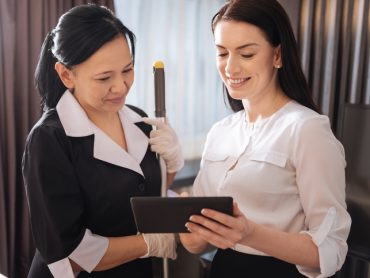Restaurant Tech Needed to Hone the Dining Surge
Many hoteliers and restaurateurs have taken a bearish stance on dining revenues as we emerge from the pandemic, arguing that eating habits have irrevocably changed as a result of so much time spent in lockdown and learning how to cook or bake for oneself. We portend the opposite for one simple reason.
Dining at home means a well-cooked meal. Dining out is an experience.
By this reason, even if you have become a master in the kitchen with all that free time and can produce dishes of the same quality as a restaurant for a fraction of the price, there is simply no comparison to the sensory amplification of escaping the house. The ambiance created by a restaurant’s décor; the sounds of other groups socializing nearby; the terse conversations with a jovial yet knowledgeable server as they dance through the aisles; even the journey to and from the chosen eatery by taxi or by foot – all this adds to the dining out experience in ways that a homecooked supper can never equate. And we haven’t even factored in that you aren’t spending hours chopping vegetables and standing over a splattering pan to make the meal happen.
Taken together, the prices paid for eating out at a restaurant are well worth it. Enjoying a new environment with family or friends over some food and drinks is an irreplaceable part of the human experience. Undoubtedly innumerous other paying customers feel the same way as we do, and this will likely result in an electrifying rush of patrons wanting to get a table at your dining establishment once late spring or early summer hits and a reasonable part of the populous has been vaccinated.
A Good Problem to Have
We’re all yearning for a return to normalcy so that we can restart the nascent service sector of the economy, but not so fast. Any surge or sharp fluctuation in order volume ultimately creates a lot of ‘good problems’; they are still issues but are associated with an upswing in revenues.
Namely, if you think in terms of staffing, one challenge with a surge is that you end up understaffing an outlet and your guests are left waiting, leading to poor meal satisfaction and hurting your reputation in the long run. Surges are hard to forecast meaning that you cannot model shiftwork requirements far enough in advance, while the pandemic has also led to many quality servers and cooks leaving the industry to thereby limit your available labor pool.
Speaking of staffing and reputation management, one vital consideration is COVID-19 safety training. That is, even though patrons may take on a somewhat blasé appearance once a semblance of herd immunity has been attained, this does not mean your staff can skimp on the municipal guidelines. So, not only must you rapidly ramp back up to a full roster in order to adequately service the surge, but you must also retrain everyone and enforce these safety measures to avoid getting a fine or some offhand criticisms on TripAdvisor about how ‘unsafe’ your business is.
Concurrently, you must also worry about facilitating the proper ingredient sourcing and diligently maximizing reservation volume while abiding by the ever-changing physical distancing stipulations.
Tech as the Saving Grace
These challenges are far too much for any single restaurant manager or F&B director to properly coordinate without a symphony of great software tools at their disposal. Getting back to the maxim from the beginning, the overall point of technology at this point is to help facilitate a great meal experience as you welcome back patrons. Moreover, guests now expect greatness when dining out because the overall quality of food made at home has been increased.
The first and most obvious step is to ensure you have all the parameters set on your online reservation platform, accounting for pacing, flexible availability cutoff points (to account for a surge of last-minute bookers) and the average turn time so that you can maximize the total number of covers you can accommodate on any single day. Even more so than the abovementioned underservicing issues, the last thing you want is to have spots closed off and potential guests opt for a table elsewhere because they can’t book directly off their phones.
Next is ensuring all your adjunctive online information is fully up to date. Hours of operations on Google, social media and Yelp must all be current, along with all the latest coronavirus safety policies. If your content is visible across a variety of websites, there are luckily a few content automation services to distribute information and keep these channels current so that your teams don’t have to manually do this and waste time. Having all this content equally accessible will mean higher reservation confidence and fewer people calling in to verify the details – a further time drain. Updated pictures speak volumes here, especially in terms of showing off your revamped patio spaces right as the weather warms.
Third is the emergence of apps devoted to the delivery of a quality part-time or shift-based workforce. Temp agencies were essential in the past, especially for banqueting or events, but now in this new normal you need staff you can trust to uphold your brand standards, coronavirus safety protocols and service quality, and outdated third-party sources often cannot provide what’s needed. Such contemporary apps help to connect restaurants or catering businesses with verified workers, acting similar to other gig economy platforms except that you can recruit past staff with good performance records instead of getting a different person every time.
Above all, what we often stress in this coming recovery is that ‘less is more’ or in this case fewer items on the menu will lead to greater efficiency in the kitchen, speedier service and error minimization. As you ramp back up, you should thus use your historical purchasing data to select which dishes and beverages are not only your top sellers but also the ones that will create the best overall experience.
Really pour over it to remove anything that doesn’t have ‘velocity’ or doesn’t add a memorable quality to the meal.
To reiterate, we’ve all spent the past year couped up inside and making exquisite food for ourselves, so restaurants have to really step up in order to wow their patrons. Our hope is that by increasing the tech stack in the right ways, you can thus ensure your staff are best enabled to focus on what truly counts.




